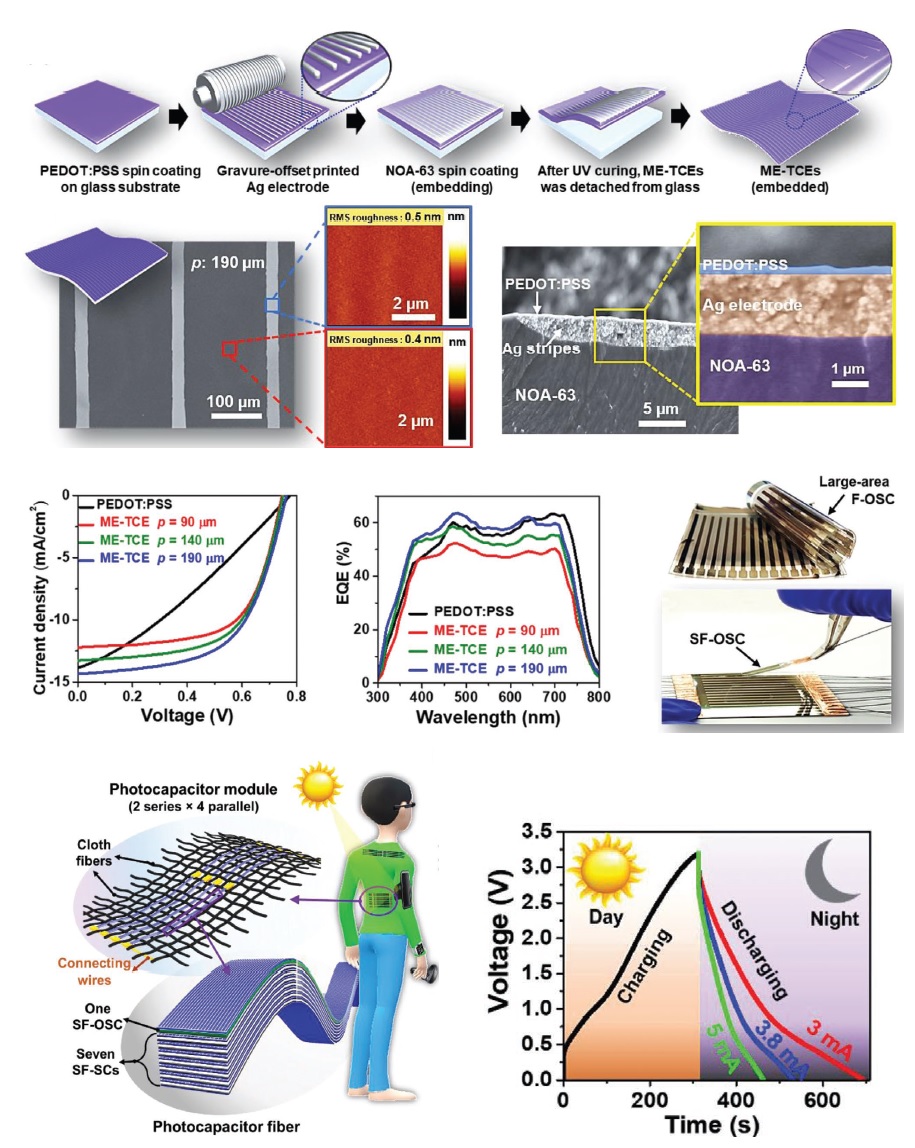- 작성일
- 2022.11.14
- 수정일
- 2022.11.14
- 작성자
- 강재욱
- 조회수
- 69
(157) W.-J. Jin, M.M. Ovhal, H.B. Lee, B. Tyagi and J.-W. Kang* “Scalable, All-Printed Photocapacitor Fibers and Modules based on Metal-Embedded Flexible Transparent Conductive Electrodes for Self-Charging Wearable Applications” Adv. Energy. Mater. 11, 2003509 (2021).

The popularity of wearable smart electronic gadgets, such as smartphones, smartwatches, and medical sensors, is inhibited by their limited operation lifetime due to the lack of a sustainable self-charging power supply. This constraint can be overcome by developing a flexible, self-charging photocapacitor that can synchronously harvest and store energy. Here, ultrathin, all-printed, and metal-embedded transparent conducting electrodes (ME-TCEs) are designed for the fabrication of large-area, flexible organic solar cells (F-OSCs) and flexible supercapacitors (F-SCs). Stripe-shaped F-OSCs (SF-OSCs) and F-SCs (SF-SCs) are obtained via slitting the as-fabricated F-OSCs and F-SCs with a surgical scalpel, respectively. The SF-OSCs and SF-SCs fully retain their performance after slitting, achieving a power conversion efficiency of ≈6.43% and areal capacitance of ≈52 mF cm−2, respectively. Furthermore, photocapacitor fibers are obtained by vertically stacking one SF-OSC and seven SF-SCs. Each fiber is fully encapsulated using UV-curable resin. When woven into a textile, the photocapacitor module (2 series × 4 parallel connections) is able to charge up to a voltage of 3.2 V in 5 min under one-sun illumination. The photoelectric-conversion-and-storage efficiency (η) of the photocapacitor module is 4.94%. The highly tailorable, mechanically robust photocapacitor demonstrated herein can be a secondary, self-sustainable power supply for futuristic wearable applications.
https://onlinelibrary.wiley.com/doi/abs/10.1002/aenm.202003509
- 첨부파일
- 첨부파일이(가) 없습니다.
- 다음글
-
(158) J.-H. Kim, S.K. Hong, S.-J. Yoo, C.Y. Woo, J.W. Choi, D. Lee, J.-W. Kang, H.W. Lee,* M. Song* “Pt-free, cost-effective and efficient counter electrode with carbon nanotube yarn for solid-state fiber dye-sensitized solar cells” Dyes and Pigments. 185, 108855 (2021).강재욱 2022-11-14 18:38:50.0
- 이전글
-
(156) H.B. Lee, N. Kumar, B. Tyagi and J.-W. Kang* “Dimensionality and defect engineering using fluoroaromatic cations for efficiency and stability enhancement in perovskite photovoltaics” RRL Solar 5, 2000589 (2021).강재욱 2022-11-14 18:22:28.0